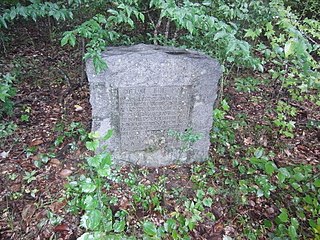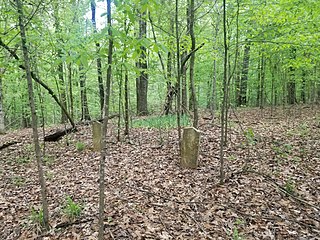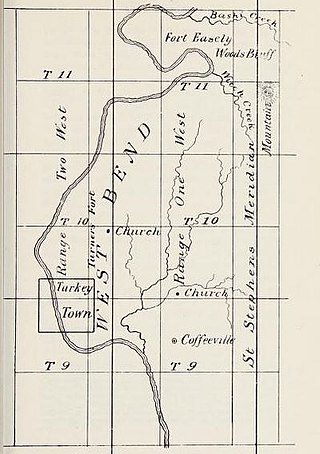Related Research Articles

The Alabama River, in the U.S. state of Alabama, is formed by the Tallapoosa and Coosa rivers, which unite about 6 miles (10 km) north of Montgomery, near the town of Wetumpka.

The Tennessee River is the largest tributary of the Ohio River. It is approximately 652 miles (1,049 km) long and is located in the southeastern United States in the Tennessee Valley. The river was once popularly known as the Cherokee River, among other names, as the Cherokee people had their homelands along its banks, especially in what are now East Tennessee and northern Alabama. Additionally, its tributary, the Little Tennessee River, flows into it from Western North Carolina and northeastern Georgia, where the river also was bordered by numerous Cherokee towns. Its current name is derived from the Cherokee town, Tanasi, which was located on the Tennessee side of the Appalachian Mountains.

The Tombigbee River is a tributary of the Mobile River, approximately 200 mi (325 km) long, in the U.S. states of Mississippi and Alabama. Together with the Alabama, it merges to form the short Mobile River before the latter empties into Mobile Bay on the Gulf of Mexico. The Tombigbee watershed encompasses much of the rural coastal plain of western Alabama and northeastern Mississippi, flowing generally southward. The river provides one of the principal routes of commercial navigation in the southern United States, as it is navigable along much of its length through locks and connected in its upper reaches to the Tennessee River via the Tennessee-Tombigbee Waterway.

The Mobile River is located in southern Alabama in the United States. Formed out of the confluence of the Tombigbee and Alabama rivers, the approximately 45-mile-long (72 km) river drains an area of 44,000 square miles (110,000 km2) of Alabama, with a watershed extending into Mississippi, Georgia, and Tennessee. Its drainage basin is the fourth-largest of primary stream drainage basins entirely in the United States. The river has historically provided the principal navigational access for Alabama. Since construction of the Tennessee-Tombigbee Waterway, it also provides an alternative route into the Ohio River watershed.

The Tensaw River is a river in Baldwin County, Alabama.
Central Alabama is a region in the state of Alabama. It is sometimes considered part of North Alabama because both regions are mountainous, but in some definitions they are different regions.

Cotton Gin Port is a ghost town in Monroe County, Mississippi, United States.

The Tennessee–Tombigbee Waterway is a 234-mile (377 km) artificial U.S. waterway built in the 20th century from the Tennessee River to the junction of the Black Warrior-Tombigbee River system near Demopolis, Alabama. The Tennessee–Tombigbee Waterway links commercial navigation from the nation's midsection to the Gulf of Mexico. The major features of the waterway are 234 miles (377 km) of navigation channels, a 175-foot-deep (53 m) cut between the watersheds of the Tombigbee and Tennessee rivers, and ten locks and dams. The locks are 9 by 110 by 600 feet, the same dimension as those on the Mississippi above Lock and Dam 26 at Alton, Illinois. Under construction for 12 years by the U.S. Army Corps of Engineers, the Tennessee–Tombigbee Waterway was completed in December 1984 at a total cost of nearly $2 billion.

Town Creek, also known as Old Town Creek or West Fork Tombigbee River, is a tributary stream of the Tombigbee River. Its mouth is approximately two miles east of Amory in northeast Mississippi.
East Fork Tombigbee River was a historical name of a tributary stream of the Tombigbee River in northeast Mississippi. Its confluence with Town Creek in Monroe County was the historical beginning of the Tombigbee. Today, however, what was once known as the east fork is now designated as the Tombigbee.

Plymouth was an early settlement in Mississippi in present-day Lowndes County. Plymouth was located at 33°31′23″N88°30′06″W on the west bank of the Tombigbee River. It was formed around 1819, developing around the fortified house of John Pitchlynn, the U.S. interpreter for the Choctaw Agency. The low-lying site of the village was prone to repeated flooding. While both Plymouth and its sister town of Columbus across the river had high bluffs, Plymouth's landing site did not have easy access to the bluff heights. By the 1840s, the village site was abandoned, as most of the residents had moved across the river to the better site of Columbus.
Oak Slush Creek is a stream in the U.S. state of Mississippi. It is a tributary of the Tombigbee River.

Prairie Bluff, also known as Dale and Daletown, is a ghost town in Wilcox County, Alabama.
Bashi is an unincorporated community in Clarke County, Alabama, United States. It takes its name from the nearby Bashi Creek that flows westward into the Tombigbee River.

The Bashi Skirmish in the Creek War was fought in what became Failetown, Alabama. A Clarke County historical marker which stands on Woods Bluff Road between Alabama 69 and Cassidy Hill marks the location of the incident which resulted in the death of 4 whites.
The Tombigbee District, also known as the Tombigbee, was one of two areas, the other being the Natchez District, that were the first in what was West Florida to be colonized by British subjects from the Thirteen Colonies and elsewhere. This later became the Mississippi Territory as part of the United States. The district was also the first area to be opened to white settlement in what would become the state of Alabama, outside of the French colonial outpost of Mobile on the Gulf Coast. The Tombigbee and Natchez districts were the only areas populated by whites in the Mississippi Territory when it was formed by the United States in 1798.

James T. Staples, officially registered as the Jas. T. Staples and also known as the Big Jim, was a Tombigbee River sternwheel paddle steamer that ran a route between Mobile and Demopolis, Alabama, during the early 20th century. She was destroyed during 1913 in an explosion while docked on the Tombigbee roughly six miles (10 km) north of the current Coffeeville Lock and Dam. It was the last major maritime disaster involving a steamboat in Tombigbee River history. The disaster saw the ship enter southwestern Alabama folklore, with tales that its sinking had been foretold by supernatural occurrences.
Horse Creek is a stream and tributary of the Tombigbee River in southern Marengo County and northern Clarke County in Alabama.
Bassett Creek, also known as Bassett's Creek, East Bassetts Creek and Thichapataw, is a tributary of the Tombigbee River that flows through central Clarke County in Alabama.
The Hatchetigbee Bluff Formation is a geologic formation in Alabama, Georgia, Louisiana and Mississippi. The youngest unit of the Wilcox Group preserves fossils dating back to the Ypresian stage of the Eocene period, or Wasatchian in the NALMA classification. The formation is named for Hatchetigbee Bluff on the Tombigbee River, Washington County, Alabama.
References
- 1 2 U.S. Geological Survey Geographic Names Information System: Bashi Creek
- ↑ "Tombigbee Tributary". Alabama Water Watch Association. Archived from the original on 12 July 2012. Retrieved 8 February 2013.
- 1 2 Ayres, Douglas W. (2012). Undaunted Curiosity: Boating America's Coasts and Waterways Volume I British Columbia to New York City. Sedona, Arizona: Trafford Publishing. pp. 218–219. ISBN 9781466919822.
- ↑ Bright, William (2004). Native American placenames of the United States. University of Oklahoma Press. p. 78. ISBN 9780806135984.
- ↑ "Geologic Unit: Bashi". GEOLEX database. U.S. Geological Survey. Retrieved February 8, 2013.
- ↑ Report on the Geology of the Coastal Plain of Alabama. Special report (Geological Survey of Alabama), Issue 6. Montgomery, Alabama: Brown Printing Company. 1897. p. 630.
- ↑ Halbert, Henry Sale (1895). The Creek War of 1813 and 1814. Chicago, Illinois: Donohue & Henneberry. pp. 219–222.
Bashi Skirmish.